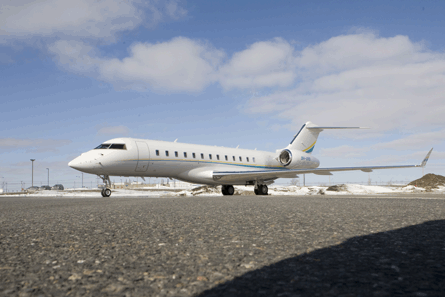In the competitive world of Formula 1, the Grand Prix drivers do not just want to be at the front of the grid and the first across the finish line, they also want pole position at the airport. So it is no surprise that they make sure they have access to the leading business aircraft to jet them around Europe and across the world to the "fly-away races" in Asia, Australia and the Americas.
But the link between Formula 1 and business flying was ever thus. As far back as the 1960s Lotus world champions Jim Clark and Graham Hill were among a handful of drivers who owned and flew their own light aircraft. Lotus boss Colin Chapman would fly himself and colleagues straight to the circuits in his Piper Navajo. By the 1970s the team "hack" had been upgraded to a Cessna 414 Chancellor, neatly liveried in the same black and gold JPS colours as his Formula 1 cars.
 |
|---|
© Mercedes F1 |
Today's drivers and team management might prefer to be relaxing down the back, rather than at the controls, but the principle is the same - they want to be in control of where and when they fly, with the minimum of fuss.
"Pretty much all the Formula 1 drivers have their own aircraft, or access to an aircraft, but these tend to be more the intercontinental types such as Dassault Falcon 2000s and Hawkers - some might have a Falcon 900," says Stephen Laven, chief executive of Fly Comlux.
Bombardier made much of its tie-up three years ago with McLaren's then rookie driver Lewis Hamilton, who become an "ambassador" for the company's Learjet products in return for access to the aircraft to travel to the European races. Hamilton, who was crowned Formula 1 world champion in 2008, no longer has a formal tie-up, says the airframer, but stills charters Bombardier aircraft.
Zurich-based Comlux has had a long-standing relationship with Michael Schumacher whereby it managed his aircraft, and has been signed up by the seven times Formula 1 world champion to provide his VIP flights to the long-distance races this season.
"You can split the Formula 1 season into two parts - the beginning and the end where the races are fundamentally long range out of Europe, and the remainder within Europe," says Laven.
 |
|---|
© ComluxMercedes GP driver Michael Schumacher will be flown to some of this year's Grand Prix races in luxury by Comlux, whose fleet includes the Global Express XRS |
This means that although the intercontinental business jet types are suitable for the bulk of the drivers' flying requirements during the season, "they become a stretch for them for the long-range races so that's where we able to work to Mr Schumacher's advantage", Laven adds.
Comlux says that the Mercedes GP team driver will extensively use its fleet, which comprises today two Airbus ACJs, two A318 Elites, six Bombardier Global Expresses (five of which are XRSs), two Global 5000s, two Challenger 850s, two Challenger 605s and a Hawker 850XP. The fleet is made up of a mix of Comlux's own aircraft and clients' aircraft managed by the company.
"I have been flying with Comlux for many years now," says Schumacher. "Travelling like this allows me to get fully rested before the Grand Prix and thus always arrive well prepared."
SEASON OPENER
Laven says that while Schumacher will use his own aircraft for the European races, Comlux is transporting him to and from all the fly-away races this year. The German driver flew on Comlux's brand-new 14-seat XRS (9H-XRS) to Bahrain for the season opener in March and to Melbourne, Kuala Lumpur and Shanghai.
 |
|---|
© Mercedes F1 |
Schumacher, who says he is "excited to fly on the XRS, which is one of the fastest jets in the world", will also use the large-cabin long-range jet to reach the end-of-season races that include stops in Singapore, Japan, South Korea, Brazil and the finale in Abu Dhabi.
"A Falcon 2000 or a Challenger would require quite a few stops to get to somewhere like Australia or China, whereas a Global has a 14h endurance, so it can probably do it either with one stop or non-stop, which makes it more attractive," says Laven. "So if you have a client who's got an aircraft on a contract with you, their own [intercontinental] aircraft can be managed as part of your charter fleet earning them revenue while they're away."
With drivers typically being in the region for a long-range race for at least at week, Laven says that to avoid flying an aircraft out or back empty, every effort is made to find charter work locally in the intervening period.
Laven says that as Schumacher is a long-standing customer, beneficial rates were agreed for his flights in return for his verbal endorsement of Comlux. But with the sort of multi-million dollar sums drivers like Schumacher can command for sponsorship deals, the Comlux agreement apparently does not stretch to any photographs being taken of the driver on board the XRS...
 |
|---|
© LotusColin Chapman's Cessna 414 Chancellor had the same livery as his Lotus F1 cars |
- All the latest news, images and video from EBACE 2010
Source: Flight Daily News























